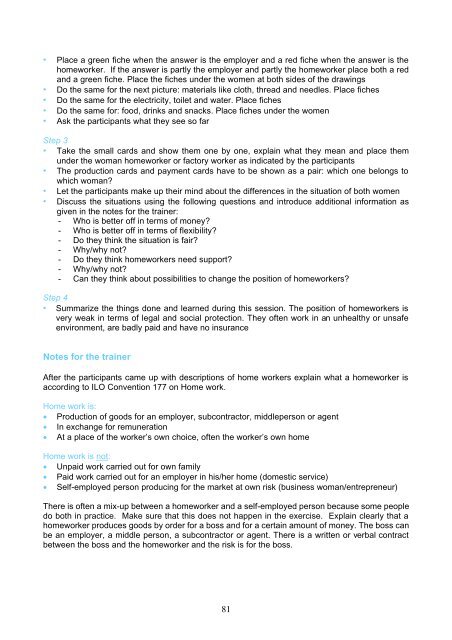manual: women workers' rights and gender equality - International ...
manual: women workers' rights and gender equality - International ...
manual: women workers' rights and gender equality - International ...
Create successful ePaper yourself
Turn your PDF publications into a flip-book with our unique Google optimized e-Paper software.
• Place a green fiche when the answer is the employer <strong>and</strong> a red fiche when the answer is the<br />
homeworker. If the answer is partly the employer <strong>and</strong> partly the homeworker place both a red<br />
<strong>and</strong> a green fiche. Place the fiches under the <strong>women</strong> at both sides of the drawings<br />
• Do the same for the next picture: materials like cloth, thread <strong>and</strong> needles. Place fiches<br />
• Do the same for the electricity, toilet <strong>and</strong> water. Place fiches<br />
• Do the same for: food, drinks <strong>and</strong> snacks. Place fiches under the <strong>women</strong><br />
• Ask the participants what they see so far<br />
Step 3<br />
• Take the small cards <strong>and</strong> show them one by one, explain what they mean <strong>and</strong> place them<br />
under the woman homeworker or factory worker as indicated by the participants<br />
• The production cards <strong>and</strong> payment cards have to be shown as a pair: which one belongs to<br />
which woman?<br />
• Let the participants make up their mind about the differences in the situation of both <strong>women</strong><br />
• Discuss the situations using the following questions <strong>and</strong> introduce additional information as<br />
given in the notes for the trainer:<br />
- Who is better off in terms of money?<br />
- Who is better off in terms of flexibility?<br />
- Do they think the situation is fair?<br />
- Why/why not?<br />
- Do they think homeworkers need support?<br />
- Why/why not?<br />
- Can they think about possibilities to change the position of homeworkers?<br />
Step 4<br />
• Summarize the things done <strong>and</strong> learned during this session. The position of homeworkers is<br />
very weak in terms of legal <strong>and</strong> social protection. They often work in an unhealthy or unsafe<br />
environment, are badly paid <strong>and</strong> have no insurance<br />
Notes for the trainer<br />
After the participants came up with descriptions of home workers explain what a homeworker is<br />
according to ILO Convention 177 on Home work.<br />
Home work is:<br />
• Production of goods for an employer, subcontractor, middleperson or agent<br />
• In exchange for remuneration<br />
• At a place of the worker’s own choice, often the worker’s own home<br />
Home work is not:<br />
• Unpaid work carried out for own family<br />
• Paid work carried out for an employer in his/her home (domestic service)<br />
• Self-employed person producing for the market at own risk (business woman/entrepreneur)<br />
There is often a mix-up between a homeworker <strong>and</strong> a self-employed person because some people<br />
do both in practice. Make sure that this does not happen in the exercise. Explain clearly that a<br />
homeworker produces goods by order for a boss <strong>and</strong> for a certain amount of money. The boss can<br />
be an employer, a middle person, a subcontractor or agent. There is a written or verbal contract<br />
between the boss <strong>and</strong> the homeworker <strong>and</strong> the risk is for the boss.<br />
81

















